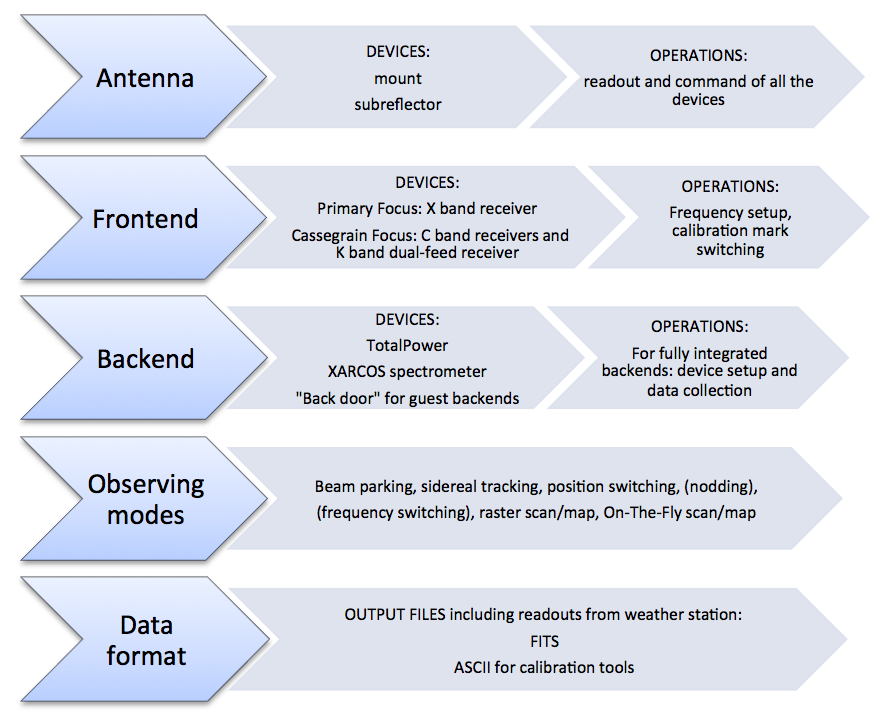Overview
What DISCOS is
DISCOS is the control software produced for the Italian radio telescopes. It is a distributed system based on ACS (ALMA Common Software), commanding all the devices of the telescope and allowing the user to perform single-dish observations in the most common modes. As of today, the code actually implemented for the telescopes (i.e. excluding the huge ACS framework) amounts to > 600000 active lines.
This guide is meant to help the observer in the use of DISCOS, without dealing with the “behind-the-curtains” complex details of the system. This release focuses on single-dish continuum and spectroscopy observations, as the fully integrated backends available on-site are the analog total power one and the XARCOS spectrometer. Since both the hardware and software implementations are continuously updated, this manual will forcibly undergo frequent revisions.
Here follows a simple schematization of the observing system, helpful to visualize all the main devices DISCOS deals with and the most important operations it performs. Notice: the features not yet available in this release are shown in brackets.

Glossary: terms and abbreviations
- >:
this symbol precedes commands to be given in the operatorInput panel
- $:
this symbol precedes commands to be given in a system shell
- Beam-parking:
the antenna points to a fixed Azimuth-Elevation position
- Bin:
frequency channel
- DF:
Dual-Feed
- FWHM:
Full-Width Half-Maximum
- HPBW:
Half-Power BeamWidth
- MS:
Minor Servo system, which includes the subreflector
- Nodding (aka “beam switching”):
it involves two or more feeds. The source is alternatively observed with each of the feeds, so that there is always one feed “on source”
- OTF:
On-The-Fly acquisition. The antenna moves according to user-defined parameters, scanning the sky at constant speed. Data acquisition is active during the scan
- Position switching (aka “on-off”):
the beam is alternatively pointed to the source (on) and to a properly defined offset position (off)
- Preset:
mount mode allowing only beam-parking observations, with no pointing model applied
- ProgramTrack:
mount mode allowing tracking, OTF/raster scans, beam-parking
- Raster:
acquisition is performed via discrete pointings (in tracking or beam-parking mode), planned to sample a certain path/area on the sky
- Section:
acquisition stream (aka “logical channel”). E.g.: the 2 feeds of the K-band receiver used with the continuum backend produce 2 feeds x 2 polarisations = 4 sections
- SF:
Single-Feed
- Slewing:
motion of the antenna when it is going to the target position. Slewing is always performed at maximum speed, with no data acquisition taking place
- Temporised commands:
user-input or schedule commands that are launched to a specific UT time by means of the “@” symbol
- Time-tagged commands:
when commands are not temporised, the philosophy for their execution is asap (as soon as possible), but the system internally schedules them associating each operation to a properly computed time. This is particularly relevant for the positions commanded to the mount, so that the antenna motions take place along a fully controlled path (except in slewing)
- TPB:
Total Power Backend
- Tracking:
the antenna points to a target and, if it’s a celestial target, follows its sidereal motion